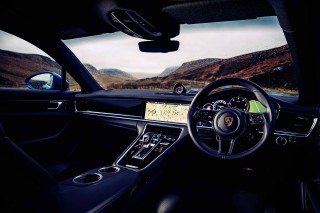
For its new Panamera 4S Diesel, Porsche has plucked the same4-litre V8from the VW Group’s engine shelf as Audi uses for its SQ7 SUV. Although it foregoes the electric turbochargers of the Audi, it does feature ‘hot-vee’ turbos between the two-banks of four cylinders. The resulting 416bhp peak power (2bhp more than a 996 Turbo Series 1) arrives at 3500rpm and hangs around through to 5000rpm, with the 627lbft slab of torque waiting for you from 1000rpm through to 3250rpm. There’s also a new eight- speed double-clutch gearbox driving all four wheels through Porsche’s electronically controlled multi-plate-clutch four-wheel-drive system. There won’t, however, be a rear-wheel-drive variant with this engine for now.
While the 4S Diesel comes equipped with conventional steel springs and active dampers as standard, until autumn 2017 you can only order it with the optional £1541 air-suspension as per our test car, which is also fitted with £1478’s worth of rear-axle steering and speed- sensitive power steering.
The original Panamera came in for a mixed response, primarily because it had looks only a mother could love and for some Porsche aficionados it wasn’t a 928 replacement. It was, however, a mighty fine way to travel four-up at speed and not be disappointed when the autobahn stopped and the straight bits between the apexes got shorter. An M5 wassharper and more focused, but the Panamera was more rounded.

This new model is more resolved visually. The rear in particular is more bloated 911 (in a good way)than featureless saloon, while inside it’s a design revolution. Out goes the Casio calculator-style button-fest, in comes an Apple-like touch-sensitive glass screen and enough tech and infotainment equipment to fill a PC World warehouse-Porsche has finally arrived in the 21st century when it comes to connectivity.
Further good news is that the Panamera still has a sports car feel to the driving position: low-slung, cockpit wrapped around you, steering wheel pulled tight to your chest, legs out straight. And it still flows down the road with a mix of grace and agility that a five-metre-long, 2050kg saloon has no right to exhibit, the rear-axle steering instantly making its presence felt on your first committed drive. The Panamera 4S Diesel is as intuitive to position in a corner, as quick to react to your inputs and as direct in its responses as many of Porsche’s traditional sports cars.

The only let down is the element I expected so much from: the engine. It’s got plenty of power, a mountain of torque and the eight-speed PDK ’box is nicely matched, but unless you select Sport mode to sharpen the throttle response and enliven the V8, it feels flat, unresponsive and no more potent than the old V6 diesel. Perhaps our test car needed more miles on it (it had covered fewer than 2000), but where I expected a surging shove and instant response there was a pause, a consideration and only a mildly stronger push in the direction you were heading.
It feels as though the car’s potential is being handicapped by its three driving modes. A tweak to make the engine’s Sport setting the norm would solve this issue, but shouldn’t a Porsche feel sporty by default? Until it does, we’ll stick with petrol-powered Panameras.
‘The only let down is the element I expected so much from: the engine’
Specification
| Engine | Power | Torque | 0-62mph | Top speed | Weight | Basic price |
| V8, 3956cc, twin-turbo | 416bhp @ 3500-5000rpm | 6271b ft @ 1000-3250rpm | 4.3sec (claimed) | 177mph (claimed) | 2050kg (206bhp/ton) | £91,788 |
+ Improved looks, sharp chassis, impressive tech – Performance doesn’t meet expectations





